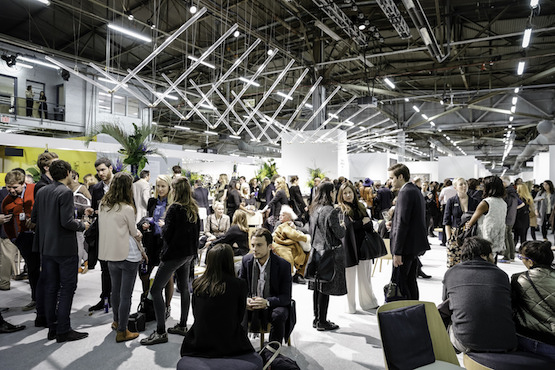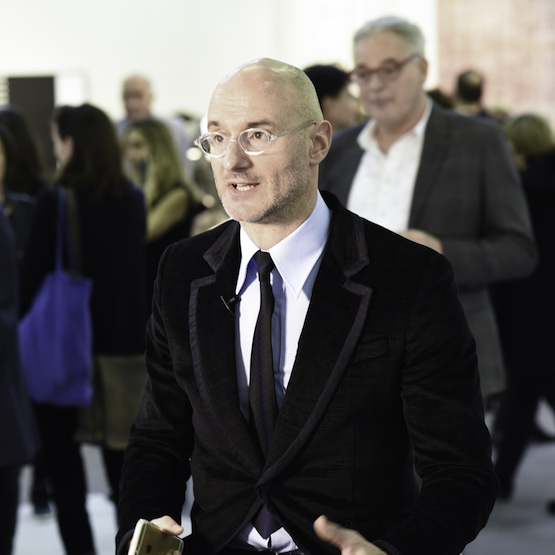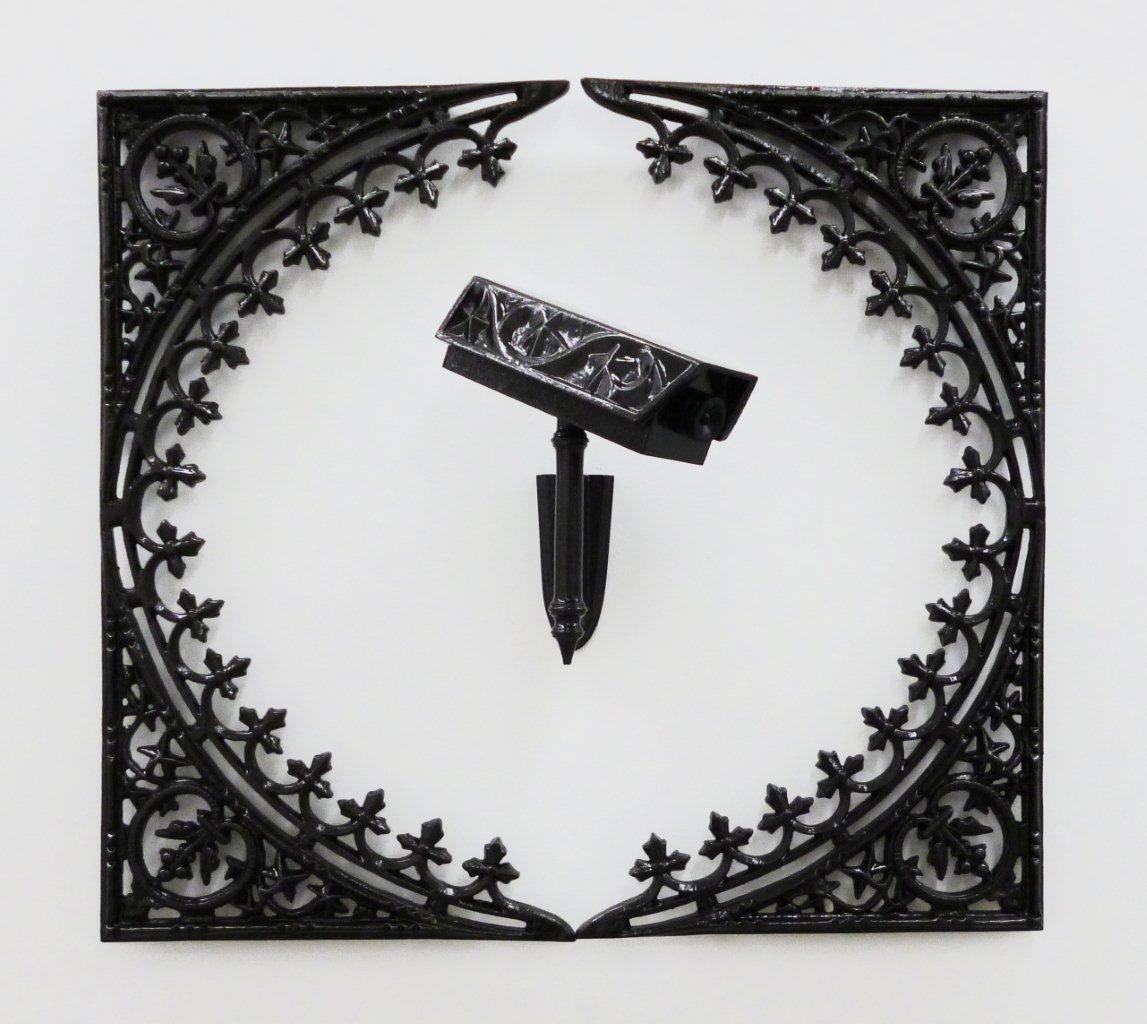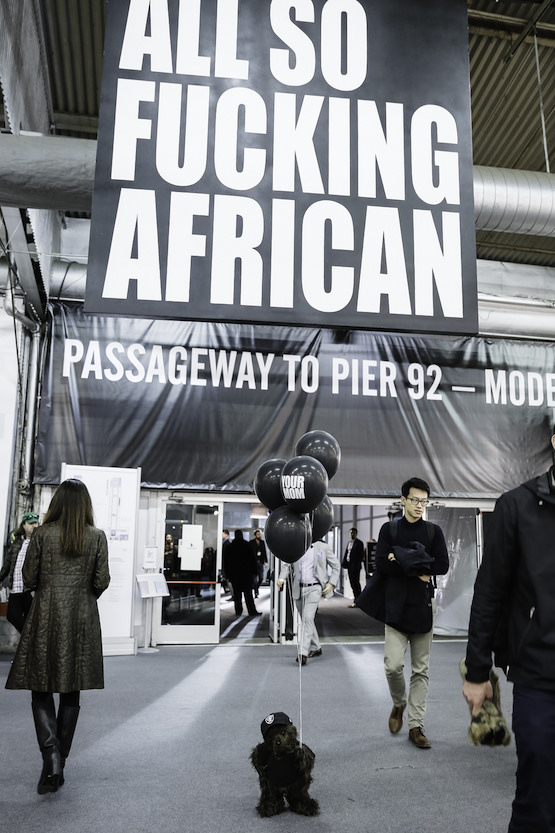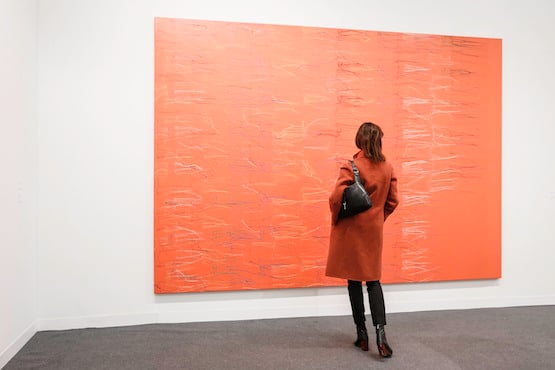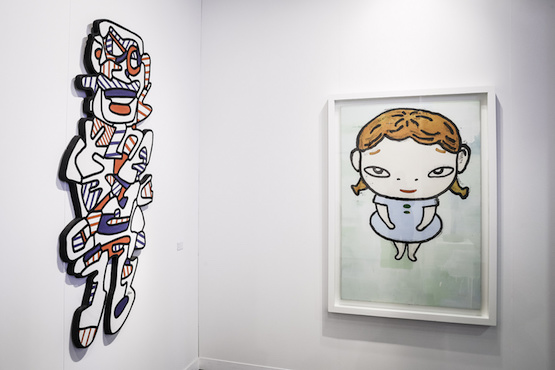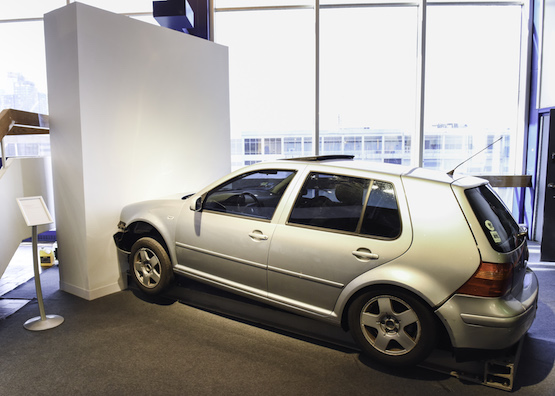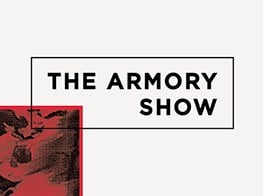Ocula Report: The Armory Show 2016
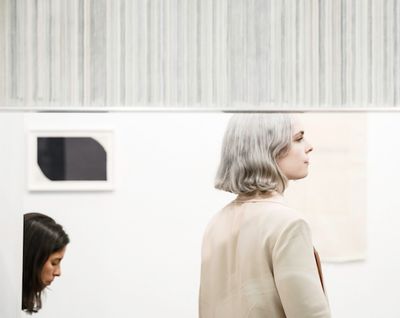
Two years after Phil Tinari curated The Armory Focus: China section, only one Chinese gallery participated in The Armory Show 2016. New executive director Ben Genocchio discusses how one of the biggest, oldest international art fairs in the world now has limited appeal for Asian galleries, and his plans to demolish the regional Focus section, which this year turned to Africa.
Image: The Armory Show 2016. Photo: © Charles Roussel & Ocula.Things were getting crazy at 11am on Wednesday 2 March, the VIP preview day at the 22nd Armory Show. Helping to navigate the crowds, a fair employee named Daniel, a twenty-something in a black leather jacket, escorted me to the media lounge, his walkie talkie emitting the occasional hiss as we went, and then, strangely, steam. He was sucking from what I’d thought was an antenna, vaping cereal milk and Fruit Loop flavored tobacco from what turned out to be an e-cigarette.
Despite questions about it's timing and venue, and the proliferation of rival fairs—including both those in New York, like the Independent fair and the ADAA’s Art Show, and those abroad, like Art Basel in New York—The Armory Show has an easiness that comes from being situated among the best museums and healthiest collector population in the world. It’s hard to imagine Daniel, efficient and conscientious as he was, working for Basel’s powerful PR machine, Sutton.
Image: Ben Genocchio. Photo: BFA, courtesy of The Armory Show. ‘This isn’t a franchise fair,’ says Executive Director Ben Genocchio. ‘It’s brought to you by the New York art world. It’s not brought to you by a bank. It’s a big, integral institution, every March—it’s the wrong time of year—but it is what it is.’
Born in Sydney, Genocchio holds three passports—Australian, American and Italian (writing this article, his name autocorrects to ‘gnocchi’.) He has lived in New York since 2002, working as an art critic for the New York Times, editorial director of Louise Blouin Media, and editor in chief at Artnet News. (I wrote articles for Genocchio at the latter two posts). He believes that experience was good preparation for his current role.
‘I understand the specific needs of each of the individual groups [at an art fair] because I think you get an extraordinary overview as a journalist. You get to speak to so many people every day and self educate.’
Genocchio has been in the job for just two months, taking over from Noah Horowitz, now in charge of Art Basel in Miami Beach. Much of this year’s event, which brought 205 galleries from 36 countries to Piers 92-94 on the Hudson River, was in place when he joined. As big and integral as it is, he’s already rethinking some key facets of the fair.
‘I think we’ll get rid of the Focus section because as popular as it is and how important it is for the media, it just doesn’t make sense to organise artists and galleries around a geographical region … Artists don’t live, very often, in the countries where they make art. Dealers in every country don’t just show artists from that particular country or region. The world we inhabit is much more fluid. Trying to define an entire section by a geographical region, where you have dealers and have their artists opening in multiple locations is inherently problematic. It’s easy to sell to the media, but they don’t question the premise.'
Image: The Armory Focus: African Perspectives. Photo: Teddy Wolff, courtesy The Armory Show. This year’s Armory Focus section, ‘African Perspectives’, interrogated the usefulness of its own ambit. Curators Julia Grosse and Yvette Mutumba, co-founders of Contemporary And, an online platform for international art from African perspectives, lamented the expectation that artists from Africa deal with specifically ‘African’ topics, writing that ‘there is no such thing as “African Art’”.’ Among the works in the section was a large billboard by Ed Young that read 'ALL SO FUCKING AFRICAN' in white text on a black background.
(Plans for the other side of the billboard, which was to read 'BLACK PUSSY' in pink on black, alluding to what Young described as ‘auto-exoticisation and the whoring of “our blacks” in the art world’, were rejected by the curators).
Image: Ed Young at The Armory Focus: African Perspectives. Photo: © Charles Roussel & Ocula.‘They already blew [the Focus section] up, right?’, Genocchio says. ‘They just rejected the concept of Africa, had a bunch of booths from Europe. They blew it up on their own, and forced the hand of the fair’.
For decades Chinese art, sold mostly to overseas buyers, was likewise afflicted by an expectation to foreground its Chineseness. When UCCA director Phil Tinari curated the Armory Focus: China section in 2014, however, he was able to introduce a younger generation of artists with more disparate concerns and visual languages, including Xu Zhen, the section’s commissioned artist. The presentation was praised, but just two years later, it seems to have had little to no impact in terms of growing the Chinese gallery presence at the fair.
‘Phil brought in some terrific galleries, and I thought the programming around the fair was excellent,’ Genocchio says. ‘I think the presentations were uneven. A lot of dealers brought a range of different Chinese artists, not all of whom were relevant in an international context.’
‘You’ve got to work out which few galleries have the capacity to be selling work at the fair, which means they have to be selling work at a certain price point, for there to be sufficient margin for them to operate in the fair context.’
Galleries participating in the Focus section receive discounts on their booths. Without the preferential treatment, who comes?
Gallery MOMO (Johannesburg) was one of the few African galleries to participate outside the Focus section, taking part for the first time after applying twice before. Just an hour into the fair, the gallery's director said there had been a lot of interest, and looked confident, despite the Rand having fallen steeply against the US dollar in the lead up to the fair, pushing up the costs of participating. While 90 percent of Gallery MOMO’s clients are based in London and New York, he said interest was not only investment driven, but also stemmed from emotional connections to the work.
INK Studio, located in Beijing’s Caochangdi art village, showed contemporary ink works by Zheng Chongbin, who has lived in the US since 1988 and takes inspiration from land artist Robert Smithson.
According to director Craig Yee, coming to Armory ‘is our opportunity to bring his newest works to New York curators who are interested in him. So folks at the Metropolitan [Museum] are very interested in him, and we’re really excited about what the Met is doing with contemporary art at the moment. We were just talking to people at the Asia Society. You may say, well these are not the traditional contemporary art venues and it’s true. My prediction though, is just look at what’s happening at the Met, look at what has been happening at LACMA in the last ten years since the arrival of Michael Goden. Look at what has been going on for many, many decades at MFA Houston: encyclopedic museums finding new relevance by programming contemporary art in an art historical context.'
Asked why there aren’t more Chinese galleries at the fair, Yee says, ‘to be perfectly honest, I think that New York and a lot of the contemporary art world got kind of caught up in a wave of collecting Chinese art that was maybe very largely investment driven, during the 2000s leading up to 2008.’
‘A lot of that work was created for us, to satisfy this notion of what [Chinese art] was about. But in fact the most conceptually edgy work and the most interesting work was not terribly commercial and was not heavily collected. So I think there’s a little bit of heart burn from that collective experience.'
‘I think that there’s a lot of really interesting art that’s being created in China today but I think that for a gallery to come to New York—it’s costing us $80,000 to do this, to get a booth and expenses—we have to make sales in order to make it worthwhile.”
Image: Kukje Gallery at The Armory Show, 2016. Photo: © Charles Roussel & Ocula.Only two galleries from Japan (Ota Fine Arts and Whitestone Gallery) and two from Korea (Gana Art and Kukje Gallery) joined Armory this year. Part of a growing regionalism. With so many fairs around the world—there are now over 200 worldwide, up from three in 1970—why should Asian galleries travel such a great distance? ‘I don’t know the answer’, Genocchio says. ‘That’s a good question. It’s something we obviously have to think about a lot.’
Image: Gana Art at The Armory Show 2016. Photo: © Charles Roussel & Ocula.There are collectors from Asia on the the Armory’s list of 12,000 to 14,000 VIPs who visit the fair, according to Head of VIP relations Irene Kim ‘but considering the portion of American and European and British collectors, it is significantly smaller. I’m not gonna lie about that. I think Asians are still developing the whole idea of going to an art fair.’
‘We don’t have a shortage of applications but it would be nice to be able to get a better mix of galleries, including galleries from Asia’, Genocchio says. ‘But the Japanese economy is in a bit of a mess, China’s slowed down, the level of professionalism outside of a few galleries is very low. The price points at which those galleries are selling makes it difficult for them to take a risk on a 100,000, 80,000, 60,000 dollar booth here. You know so these booths have to make sense economically to the dealers, and I have to sit down and think does this make economic sense to a gallery from China, Japan, Korea. Just as it doesn’t make sense for a lot of dealers to go to Basel in Hong Kong.’
Going on the offensive, Genocchio says, ‘Art Basel in Hong Kong is in trouble. Did you see [Art Basel’s global director] Marc Spiegler is here doing every single booth yesterday? "Come to Hong Kong, come to Hong Kong, come to Hong Kong." The market there is not big enough, and Basel charges a fortune.’
The bluster of a competitor may not mean much, but Art Basel in Hong Kong nevertheless faces challenging conditions. According to the TEFAF Art Market Report 2016, the Chinese art market contracted a whopping 23 percent last year, while the US market grew by four percent.
For what it's worth, Genocchio is just as blunt about his own art fair as those of his rivals.
‘I’m not fundamentally interested in the idea of an art fair; I’m interested in art work’, he says. ‘And I’m interested in finding ways of displaying artwork that are interesting and innovative and the art fair is a way of doing this. Yes, it has to be a functioning business but I’m not interested in the idea of an art fair as an art fair because it’s an artificial construct.’
That might sound incendiary coming from someone who, in another line of work, would still be under probation. Shouldn’t Genocchio be more circumspect when talking to media?
‘I don’t care. To what end? I could pass you the corporate message but it would sound like bologna. Total bologna. I never took that nonsense, and I never would write it anyway. I find it disrespectful, frankly, when someone just reads you the press release and expects you to go away and write it.’
Sunlight was streaming in the window on the afternoon of Friday, 4 March, as Jonathan Schipper watched over his Slow Motion Car Crash (2012-2016), one of the fair’s Special Projects. A Volkswagen was slowly slamming into steel beams, concealed behind drywall, at a rate of fewer than three inches per hour, impacting 36 inches over the course of the five-day fair.
Image: Jonathan Schipper, Slow Motion Car Crash, 2012-2016. Photo: BFA, courtesy of The Armory Show.Schipper, a Brooklyn resident in a black Stetson, said this was his second time using this exact model—‘your every man’s car, or every German’s car’—and that it had been ‘sourced locally’.
‘The windshield is safety glass, it’s laminated, but it will probably crack and you’ll see these spidery things’, he said. ‘The side windows actually explode into little bits, the tempered glass. I think the idea is if a rock hits this you don’t want it to just disappear, and if you’re in a car crash you want to be able to get out of the window. We put tinting film on it to protect the viewers. Only one window has ever exploded on the side but it’s exciting and super loud. You’ll probably see it before it happens because it takes a lot of force. Usually you see it start bending a bit before it cracks.’
Schipper says we invest our egos in our cars, and they become extensions of our bodies. Seeing them coming undone makes us contemplate our own inevitable undoing.
‘Eventually we’re all going to come to an end’, he says. ‘But this specific event is so hard to see and understand if you experience it; it’s full of adrenaline and that affects your memory. If you see it on film you’re just looking at a very specific [perspective]. This allows you to be close to it, take the drama out of it, be more contemplative. I often think of watching a log burn, it’s a lot like that. You can’t help watching it. It’s this amazing thing where it’s going from a really high state of order to a really low state of order, and the same thing’s going on here.’
The same could be said for art fairs individually, and as a phenomenon. Fairs cram so many works into a few short days that they're almost violent towards contemplation. Similarly, the proliferation of art fairs has happened way too fast for dealers and fair directors to understand what’s really going on, to know which ones will buckle and shatter, and which ones will plough ahead unimpeded. —[O]

